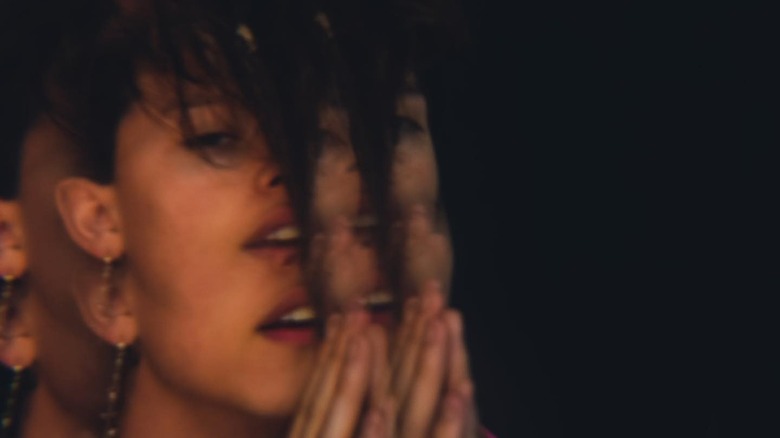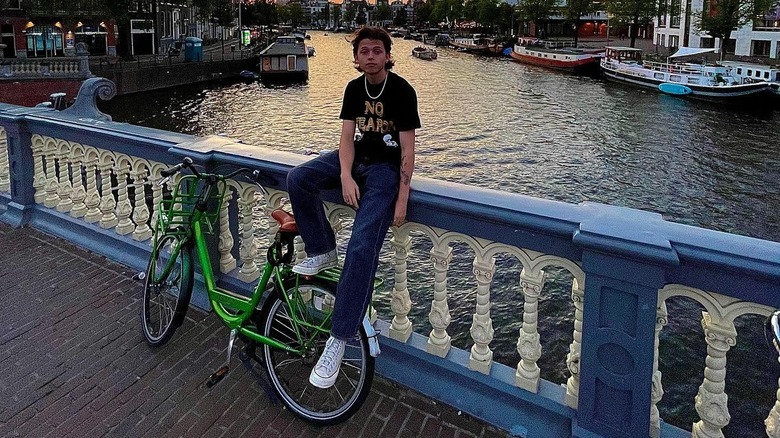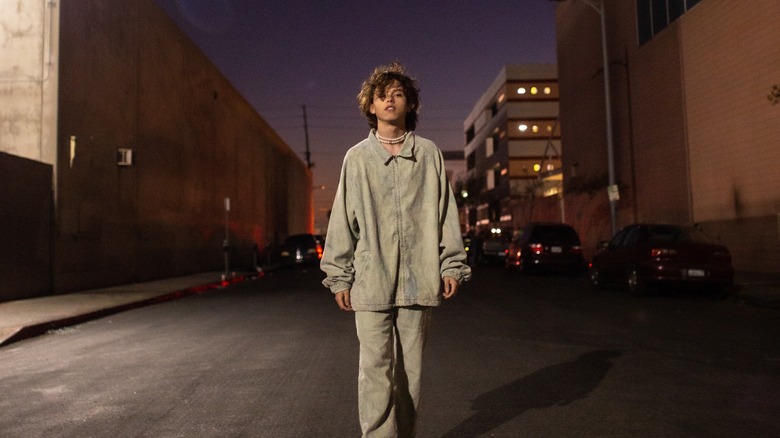Musician & Filmmaker Jacob Sartorius Reveals How The Wim Hof Method Changed His Life - Exclusive Interview
Jacob Sartorius is one of those people who excels at creating connection. His incredible charisma was apparent from the moment he started posting videos on Vine and then Music.ly, and he built a massive following on both apps before they were discontinued. Sartorius' social media fame allowed him to pursue his lifelong dream of becoming a musician. He released his first single in 2016, and by 2017 he was touring the world to perform in sold out venues. Since then, Sartorius has released several albums, multiple hit singles, and reached the echelon of pop stardom.
But Sartorius found that life at the top wasn't what he expected. He had to deal with his fair share of Internet bullies, as well as the constant judgment of the public. This exacerbated the anxiety and depression he'd dealt with for most of his life. Sartorius revealed that he was on antidepressants and anti-anxiety medications and that he regularly attended therapy, but his mental health continued to get worse, making it hard to even get out of bed some days. Eventually, he decided to take some time off from his career to focus on his mental health.
That's when Sartorius's therapist introduced him to the Wim Hof Method, which completely changed his life. In an exclusive interview with Health Digest, Sartorius explained the Wim Hof Method, how it's changed his physical and mental health, and why everyone should give it a try at least once.
An introduction to the Wim Hof Method
Can you give us a little intro to the Wim Hof Method of meditation? What does a practice look like for you?
The Wim Hof Method is made up of two different components. It's deep breath work and cold exposure. The mix of those two has really provided me with a lot of inner peace. It looks like 30 or 40 deep breaths, real deep into the diaphragm, oxygenating the body, and then right after that breathing, after exhalation, you'll hold. It's a meditation process which is about four rounds of deep breath work, about 30 to 40 breaths, and a hold after exhalation, and then a deep breath in and squeeze to the head, and that's the breathing component.
The cold exposure is either a cold shower or an ice bath. Ice baths are the real way to go, but I do a cold shower daily because that's what I have access to. It still gives me that buzz of the cold and that's what it's made up of and yeah.
How were you introduced to the Wim Hof Method?
One of my therapists asked me, "Have you ever tried breathing before?" I was like, "Yeah, dude, I've been breathing for about 18 years." He was like, "No, no. I mean like conscious breathing, focused breathing. Let me send you a link. I really think you'd benefit from trying this."
I'm very thankful for him sending me that link because I went on to try it and had a great experience the very first time I did it. I was in this state where I really wasn't very open to trying a lot of these different meditations, but this one broke through to me. I did feel a sense of calm almost immediately, maybe after five breaths. I started implementing it into my daily schedule. It became [something regular], and now it's been over a year and a half of consistently doing this breath work mixed with the cold exposure.
The daily practice
Tell us a little more about how you actually incorporate that into your daily practice. So what does your schedule look like incorporating the breathing?
I wake up and the first thing I do is the breathing. It's either a guided meditation on YouTube, which is free for anybody out there that wants to try it. I actually have done it a lot and I know how the rounds go. I'll do it off the recording and go outside and lay out on a towel. In the morning ... It's very important that I do this before checking social media or getting involved in the internet because it allows me to have a second to go somewhere else for a little bit, then come back, and I feel like I have better focus. My day starts with the breathing.
After that's done, then I do the cold exposure, which is a cold shower. For example, today, my hair is still wet. I just did one, it was about three minutes and 30 seconds. I think anywhere after two minutes and 30 seconds gives you that rush that you'll want, but I didn't start doing that. I started with doing 30 seconds and then every day adding 10 more seconds. It's within the willpower. It's a cool little challenge to start the day.
Do you do that breathing once a day, or more than once a day?
There are days where I definitely do it more than once a day. If I'm feeling stressed, it's a great way to get through the stress completely. There are days where I do it [more], but most days, it's once in the morning, and that's enough to get me going. It's like a cup of coffee.
The physical and mental benefits
You've actually been pretty open about your struggles with depression and anxiety. How have you seen your mental health improve since you started incorporating the Wim Hof Method?
It's been a huge increase in positivity. It feels like I've entered this cheat code into my system and I'm able to have a second chance, because for a while I really ... People would be shocked to see this right now, me talking about this ... They'd be excited.
In the past I've been so blocked by anxiety, blocked by depression. I felt like I was waving through a window. I didn't feel like I was part of it, and now, this has allowed me to, whether I am or not a part of, it's allowed me to find some peace within myself, which was the thing that I didn't, or might not have realized, was needed. To actually go out, you have to go in, too.
Have you seen any improvements with your physical health?
Absolutely. When I went over and saw Wim, this was the first time he had really showed me the benefits ... After the breathing, [you feel like it's] in your control to do more. You can actually work out way more. For example, he had me do push ups before we did the breathing, and I was able to do 10. After the breathing, I did like 25, and I was like, "Whoa."
It's because there was some sort of control and peace and willpower. I was like, "Wow, there's something to this," that it goes past thinking straight into feeling and it gives you this boost that can really give you ... it makes me feel good. It does help with working out right after the breathing.
Meeting and studying with Wim Hof
You just mentioned it – you actually went out and met Wim Hof for the documentary that you did. Where did the idea for the documentary come from and how did you hook up with Wim Hof to actually meet him?
The first person that told me about Wim Hof was my therapist at the time, and he still is my therapist – honestly, a great guy. Shout out to [him]. That was the first time I had heard of it. Then, I started trying it. Once I felt the effects, I was like, "Yo." I became a super fan of Wim Hof. I watched every Wim Hof interview. I followed him on Instagram. I kept up with all the socials.
One night, I DM'd him on Instagram. I sent a long DM. I could pull it up, actually. I said that I'd love to bring this to the younger generation because of how much it had helped me. It was some intuition [that] told me to send this DM. It was a really cool thing because I actually got a reply, and it was from his son Enahm Hof, [who] runs most of his social media and stuff because Wim's a little bit more off the grid. Enahm was like, "We'd love to do it! Here's our email. Let's have our teams be in contact."
From there, it gave my team the contact, and we scheduled a time about two months out from when that was. I was really looking forward to it. Before [we met Wim Hof's team], I reached out to my good friend, Sam Cahill, who's directed some of my music videos. I call him on the phone and I'm like, "Dude, we can go meet Wim Hof!" He knew who Wim Hof was and he was excited and he was down to help me bring this to life by directing it and helping me film it. He filmed it and edited it. [This] was a really cool thing, because it was teaming up with a friend of mine to go on this journey to go meet this spiritual guru.
It was one of the most enlightening times I can recall. It was one of the best days. I remember being in the car [on the way] back like, "Wow, there's so much to process with what just happened, and there's so much more that I can do, after looking at Wim, to stay alive." A lot of people struggle with mental health, and I'm sure he sees a lot of people that are struggling. They get to break through the trap, or the lens, that it feels like you're looking through when you have this anxiety.
A free and natural way to improve mental health
It can be disabling in some ways. I remember there was a time where I didn't want to get out of bed for quite a while. For over a week, I felt physically and mentally exhausted. The two had met and I was defeated, in a way, and questioning what would be the thing that [could make me] move forward.
This has provided me with a natural way, so I don't have to harm myself like I might have used to in the past. This has allowed me to see the other side in a way, or at least get a glimpse. I'm seeing the light at the end of the tunnel every time I do this breathing, and it gives me the focus and it strengthens my willpower to want to keep moving forward. I think everyone would benefit from at least trying.
It's a free resource and that's what attracted me. I felt like everything was a sales pitch. I was on prescription medication for years for my anxiety and depression, and it helped at times, but towards the very end of taking that was when I found the Wim Hof Method. I've been completely off all prescription medication since finding it. [The Wim Hof Method] replaced that as a natural way for me to use ... as a crutch, almost, to help me. I'm very confident in that.
I've met other people, like Mike Posner, that are practicing this Wim Hof Method. It's spreading worldwide, and Wim definitely has that as the goal. He wants to reach billions of people, as he says, and impact them. He definitely impacted me, and I hope that if I'm able to tell these stories to people or relay the message that somebody could be saved and that's what's powerful about this.
To that point, why do you think it's so important to share this practice with other people?
Because it is saving lives. It's allowing you to lower your stress naturally. It's allowing you to, when you get into the cold shower, increase dopamine by 2.5% more than your normal levels. It's crazy. This is giving you a chance to feel alive, and it sure has done it for me. It's been a personal experience, but there's so many people I see online that are sharing their journeys of doing the Wim Hof Method.
Overall, it could provide someone with a resource that they didn't know was out there. I had no clue this existed, and if I had known earlier, I would've been doing it if I could [have felt] the effect of how this [has] made me feel, how it's allowed me to have balance in my life. A lot of people — not everyone — but a lot of people would benefit from trying this.
The power of a cold shower
You've mentioned the cold showers a few times. When you were with Wim Hof, you actually did the ice bath. Can you tell us a little bit about that experience?
It was cold [laughs]. As everyone says, it's real. I didn't know. That was my first ice bath ever, and, oh my gosh. If you check out "Breathe" on YouTube, the documentary, I get in for a second and I have to get out. It was enough for me to be like "Whoa!" My whole body tensed up, and I was freaking out. I started almost shaking because of how cold it was.
I had just watched Wim be in there for at least five minutes, talking, and then he was like, "I can get out now." He calmly gets out and it was like, "Whoa. He's mastered this feeling of discomfort, remaining calm through any amount of discomfort," which is something that you can take with you in your day-to-day life, if there are triggers or times where you want to get like that.
He told me, "Remember why you came to Amsterdam." He gave me this motivational speech and I got back into the ice bath, and I was able to stay for at least over a minute, which was wild compared to four seconds of me going down and then getting right out. It was about ... Controlling the breath was the thing that really helped me, [slowing] down the out breath. He kept saying, "Slow down the out breath." I went, and you can see it in the doc. When I let it out more gentle, the jittery and the craziness calms down for a second. I was able to be like, "Whoa."
From then on, I was hooked because I did feel high after doing that ice bath. I have to say I was high on my own supply. That's what Wim says, "Get high on your own supply," because it sure gets you ... It got me awake. It makes me feel good and enough so to keep doing it every day. Every time that I do the cold exposure — now it's cold showers, which are a little easier — when I'm doing the cold showers, I find that I'm able to fight ... There's a part of me that still doesn't like cold water. It's uncomfortable for anyone, but it's like training the mind and it's more like a tolerance, honestly, to cold water. You don't love it, but every time you do, it's within the willpower because you know that you've done it before.
It's about starting that journey and growing with yourself. It's a really powerful thing that can, and does, help tons of people all over the world. It's got me inspired to want to become a Wim Hof instructor. Mike Posner is now a certified Wim Hof instructor, and that was very inspiring for me to see someone that makes music, that's found this journey of going outside of themselves and focusing on the world.
Bringing the practice into daily life
There's so much outside of what we do in our hobbies that we can really connect with a lot of people. I have fans that'll DM me, "Hey, I tried a cold shower today. I feel great." I'm like, "Let's go!" Because I know what that feels like when you find that thing that can help you. It's an amazing resource.
You've touched on a little bit of this throughout, but can you elaborate what are the lessons that you bring into your daily life from these practices? What do you take with you when you're done with the breathing and the cold showers?
I definitely take a whole new perspective with me. A lot of times when I wake up and I go to the breathing, I'm a little anxious. I'm thinking, "What do I have to do today? What's going to go on?" I force myself to go start breathing dude, because I know that's my thing. I know if I don't do that, days will pass. I'll forget about it and I'll be anxious and I can't let that happen. I'm on a streak now. It's over a year of doing it. It's become part of my thing, but it changes my perspective.
When I go to the breathing, I'm a little anxious. Naturally, I'm a little anxious. When I leave the breathing, I'm a different person. I actually feel different. I'll look at colors and they're brighter than normal. I'll look at anything. I feel like it's all ... a lot more gratitude, actually, after doing the breathing. I'm a lot more grateful for a lot of these little things in my life that I sometimes take for granted.
[It's] a new perspective, a lot more gratitude, a feeling of love, a sense of wholeness, because sometimes, especially with the mental health, the mental health stuff is still a constant battle, and it's something that you got to take care of. I know that by doing this breathing, I'm aware that I'm in the process of improving my mental health.
There are days where I'll sit down to breathe and my thought process is all over the place. "Well, why do you got to do the breathing today, man?" That's what I'll be telling myself, and I have to remind myself to see what's on the other side of that thought. To not follow that one, but follow the one that says, "Just breathe." I have it tattooed on me, "breathe," because it's real. I don't know how to express it enough. I will be literally the guy that'll tell everyone about this because it feels like the right thing to do. I'm grateful to Dr. Saylor for telling me about this resource, and I hope that I can tell as many people, because truly it feels like if more people knew about this, the world would be a safer and a happier place. 100%.
Resilience through difficult things
With the ice bath and the cold showers, it sounds like you're talking a little bit about that resilience building, and sitting through difficult things. Can you speak a little more on that? Where does that show up in your daily life?
It's willing to go into discomfort so that the rest of the day is comfortable, honestly. The cold [causes discomfort]. It gets you real cold, but afterwards, after you've been through that battle with the ego. Wim Hof says, "The ego has to die once a day and we have the power to kill it." That's what he always says. When you do the cold, you really see that it's like, "Okay, this is not comfortable, but if I stay here, I know that this is going to reduce stress. This is going to lower my inflammation. This is going to increase my adrenaline. This is going to give me three hours of adrenaline, up to three hours of increased adrenaline for the rest of the day."
Wim Hof calls it the reptilian part of our brain, which is the doing instead of a lot of the thinking. For someone that's an over-thinker like myself, during that discomfort of the cold, I'm thinking through a lot of stuff. I'm almost preparing myself for moments. A couple of weeks ago, I went to the bowling alley, and when I did the cold shower that day, I prepared for the bowling alley. I get overwhelmed easily, and I still am a little bit anxious, but I prepared for this. I did the cold, and I was thinking, "Okay, there's going to be loud music. There possibly could be someone that comes up to me and says hi, and I have to be ready for that. There could be someone that doesn't even like me and they come up and do something, so I got to be ready for that. What if one of my friends says something that triggers me?" All these things get me to that same feeling. I'm willing to go to the cold so that I can work through those emotions.
And then afterwards, if those things do happen, let's say someone did come up at the bowling alley. I'm able to say, "Hey, how's it going?" It's like, I'm here. I've already gotten over the "What could possibly go wrong?" [I can play] out all those scenarios of what could go wrong and be like, "No, I've already done the uncomfortable part of the day." I look at the breathing and the cold as the uncomfortable part. In a way, it's doing the work to feel better, and then the rest of the day, it really works.
There are times where it still gets to me. There will be things that still trigger me, and that's for everyone, but it definitely helps in controlling that, or at least the willpower of feeling like you have control over it. We get mad. It's not like "mad" happens to us. That's how I look at it. We're somewhat responsible for some of these emotions or at least have some control over them if we feel we don't.
A message for anyone who's struggling
What's one thing you would want to say to people who are still struggling about what this can do for them?
[The Wim Hof Method] might not be right for everyone [reading] this, but you should give it a try because as someone who has been on prescription medication, struggled with not being good to myself, making healthy choices, this has allowed me to create a gap where I'm able to have a different perspective on the things that I'm doing and the patterns that I have in my life. I would not have had any of this perspective without this method and the experiences that I've had with it.
Aside from that, you're so strong, whoever you are out there, and keep the faith alive no matter what. You don't got to go do the Wim Hof Method if you don't want to, but always remember that you are loved a lot more than you think and keep the faith alive, because there's so much good coming.
If you want to see the light at the end of the tunnel, try the Wim Hof Method, because you might get a little glimpse of that light. Either way, know that the light is coming, and sometimes it takes time to work through these uncomfortable stages. I've been in many of them and I probably will go through many more, but throughout it all, it's cool to have a resource that's natural.
Aside from a resource, know that you're powerful, you're strong, you're loved, and you're capable of anything. It's mind over matter. Also, a quick little tip for anybody that might be depressed or anxious, it's harder to hit a moving target. The more that you can try your hardest to ... If you find yourself zoned out or focusing on negativity and it seems to be overwhelming and paralyzing in a way, try to combat that by moving around a little.
Be kind to yourself, too, because this is not something that works [immediately]. I'm still working on it. I'm in the process. Be kind to yourself, number one, and try to keep the faith alive. Everyone [opening this interview and reading it], you're all individual people with a unique set of perspectives, which is how you look at the world and choose to embrace that. That's what makes you really cool.
Watch Jacob's debut film, "BREATHE: The Documentary," here, and watch the official video for Jacob's latest single, "WORTH IT," here.










